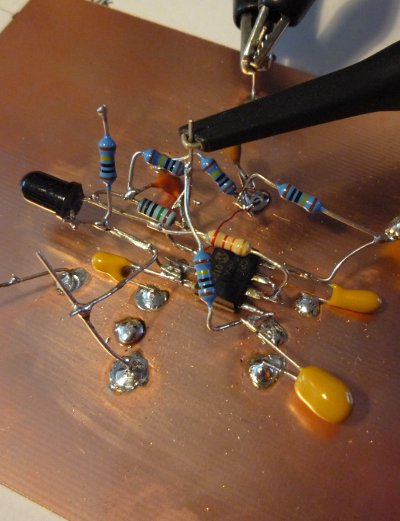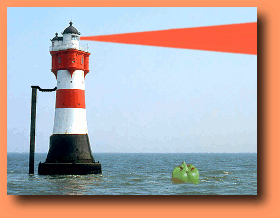RayDialer
Some experiments about (simple) optical positioning in the living room.
NOTE 5/2012:
I deleted most of the drivel in the "TX1-section" (*1*).
Although some information might be missing right now, it reads
a little easier...
Features:
- coded IR beacons
- real-time, 4 channel directional receiving pattern
- beacon messages (pro version)
- external beacon communications interface (pro version)
- measuring distance to single beacon (pro version)
- "easy" (...) to build (reduced version)
- some more "blabla" I forgot to put in here...
- ...
This minimal positioning system consists of three parts:
- TX1/2: transmitting beacons
- RX1/2: directional receiving circuit
- MX1: omni-directional motor mount (radar; pro version, not presented here)
Raydialer-TX1
Less drivel than before... (*1*)The TX1 part of RayDialer, at least like presented here, consists of 3-12 IR LEDs, emitting base band amplitude modulated light. The modulation can chosen to be:
Right from the start, RayDialer-TX1 was planned to emit more than only one frequency component. This reduces detrimental effects from other, interfering light sources and adds a little more confidence to the received and analyzed signal. Although the TX1 PCB (a little, overengineered multi-purpose device) is prepared for a PIC, all tests and further experiments were done with a ready-to-use DTMF "encoder".
There are a lot of ready to use DTMF chips available. I decided to use a HT9200. It can be operated in parallel
or serial input mode. Parallel mode only requires four pull-up or -down resistors to select one of the 16
different DTMF tone combinations. Additionally, a chip enable pin can turn the output on or off.
Complete DTMF Frequency Table
=================================
1209Hz 1336Hz 1477Hz 1633Hz
697Hz 1 2 3 A
770Hz 4 5 6 B
852Hz 7 8 9 C
941Hz * 0 # D
Despite the non-linear behaviour of the transistor Q1, the current flow through LED1 will be proportional to the voltage output of the HT9200. A coarse approximation (DC only):
Iled = (Udtmf - Ube) / R1
<=> Iled = (2.5V -0.65V) / 82Ohm <=> Iled = 23mA
The preceding, minimal circuit has many flaws:
Hardware
|
Raydialer-RX1
RX1, The BeginningRX1 detects the direction of one or more transmitter(s) by measuring the signal intensity at at four different angles. Thanks to a tiny, but powerful dsPIC, all channels are sampled simultaneously and analyzed by a real-time Goertzel-Algorithm.If more than one TX1-beacon in DTMF-mode is in the reception range of the receiver, it can only distinguish those with unique frequencies:
This issue got addressed with the TX1-RX2 combination (upcoming attraction).
The differential signal input of two (or more) adjacent diodes is not used for position detection, only for a quick, first "guess" across an angular span of 160°. For operation, only one diode would be required, but four speed up things dramatically...
The circuit consists of four equal detection circuits (CH1-4).
Because only a single supply is available, R2, R5 and C4 provide an 1.65V offset for the circuit.
The output signal, including the offset, is filtered by R4 and C5 (arithmetic mean,
time constant ~10s (a little large, I agree ;-)) and fed back to the negative input of the photodiode
amplifier via the second half of the MCP. The dsPIC provides a serial (115k, 8N1), as well as an I2C interface. For NXT compatibility, choose R23 and R24 to 82k. For real world I2C interfaces, reduce them to ~2k2-10k. The processor had some spare pins left, so a tiny LCD was added to the test layout. It has to be mounted via IC-sockets or stuff like this. to be continued... (11/2010)
Firmware RX1
Number of Goertzel steps (samples) and effects. Download this Scilab script here, or use SiSeLi ;-) Notice that the output values are NOT NORMALIZED (divided by the number of samples)! Use the source ;-) 
incredible, that's from 2010? (5/2012 ;-)
Commands
HOTKEYS (UART, 115200,8N1 or I2C):
=================================
ESC stop (after current operation)
d DTMF mode, all channels (4), all frequencies (8)
D DTMF mode, single shot
s sweep mode
S sweep mode, single shot
a sweep output for all channels (only serial)
0 sweep output for one channel only
c sweep channel selection (one channel); requires IDLE_STATE; followed by:
1 select channel 1
2 select channel 2
3 select channel 3
4 select channel 4
ESC aborts channel selection
f sweep frequency range selection; requires IDLE_STATE; followed by:
1 select tone 1; sweep f1-47Hz..f1+48Hz
2 select tone 2; sweep f2-47Hz..f2+48Hz
...
8 select tone 8; sweep f8-47Hz..f8+48Hz
a select tone 1..8 sweep f1-47Hz..f8+48Hz
ESC aborts range selection
r reset max marker (horizontal bar resolution) for LCD value normalization
l linear intensity axis on LCD
L logarithmic intensity axis on LCD
1 250 steps per Goertzel analysis
2 500 steps
3 1000 steps
4 1250 steps
5 1500 steps
6 1750 steps
7 2000 steps
8 2250 steps
9 2500 steps
o output as magnitude
O output as power (I2C always uses magnitude)
? show help message
h show help message
UART Interface115200, 8N1
UART OUTPUT FORMAT IN DTMF MODE:
================================
<channel>,<f1>,<f2>,...<f8>
START_DTMF
1,1982,1559,974,14,284,2,96,518
2,1985,1508,978,19,289,2,103,511
3,1774,1487,281,473,788,377,557,117
4,1793,1433,291,468,718,370,552,110
STOP_DTMF
UART OUTPUT FORMAT IN SWEEP MODE (ALL CHANNELS):
================================================
<channel>, <frequency>, <intensity>
START_SWEEP
1,650,2221
1,651,2149
1,652,1356
1,653,347
1,654,10
1,655,614
1,656,1583
1,657,2030
2,650,2103
2,651,2046
2,652,1284
2,653,319
2,654,24
2,655,667
2,656,1650
2,657,2062
3,650,1926
3,651,1501
3,652,483
3,653,0
...
1,1002,10
1,1003,614
1,1004,1583
...
4,1703,1501
4,1704,483
4,1705,4353
STOP_SWEEP
UART OUTPUT FORMAT IN SWEEP MODE (ONE CHANNEL):
===============================================
<channel>, <frequency>, <intensity>
START_SWEEP
1,650,2131
1,651,2093
1,652,1332
1,653,315
1,654,21
1,655,658
1,656,1633
1,657,2084
1,658,1640
...
1,1704,1344
1,1705,112
STOP_SWEEP
I2C Interface
I2C WRITE:
==========
ADR BIN-ADR I2C-BYTES (the "NXT-STYLE")
0x48 0b 1001000 0x90
(0x49 0b 1001001 0x92)
(0x4A 0b 1001010 0x94)
(0x4B 0b 1001011 0x96)
+-------+-------+
| <ADR> | <CMD> |
+-------+-------+
<ADR> = standard I2C 7 bit address + !W bit
<CMD> = ASCII command as described in "HOTKEYS" table above
For a write command, there is no difference between 0x48 and the other addresses.
Just stick to the first one...
I2C READ:
=========
CH ADR BIN-ADR I2C-BYTES (the "NXT-STYLE")
1 0x48 0b 1001000 0x91
2 0x49 0b 1001001 0x93
3 0x4A 0b 1001010 0x95
4 0x4B 0b 1001011 0x97
+-------+-------+-------+-------+-------+-------+...+-------+
| <ADR> | <STA> | <T1H> | <T1L> | <T2H> | <T2L> |...| <T8L> |
+-------+-------+-------+-------+-------+-------+...+-------+
<ADR> = standard I2C 7 bit address + R bit
<STA> = Raydialer status byte (not in use)
<TnH> = tone level, high byte
<TnL> = tone level, low byte
Per channel (receiver photodiode), 17 bytes are returned.
Each high/low byte combination represents a 16bit magnitude value of a "tone".
"Tones"
FIRMWARE TONES:
===============
TONE f[Hz]
1 697
2 770
3 852
4 941
5 1209
6 1336
7 1477
8 1633
|
Lego
|
RobotC DemoThe provided example (see download section below) does nothing else, but align the brick with three TX1-beacons. Additionally, it balances on two wheels, but this is a different story. That's it for now. Nothing more, nothing less...
pbLua Demopending...
NXC Demogähn... |
Useless Pics
|
minimal TX (pure analog) 
|
minimal RX 
|
|
totally saturating the receiver; still working ;) 
|
Well, not quite exactly... The S817 isn't really that large ;-) 
|
the real RX1 hardware
|
...
|
TX mounted on a battery pack
|
do NOT attach a 9V battery ;-)
|
Download
RayDialer:
Includes:
- schematic (PDF)
- placement (PDF)
- layout, Eagle (BRD)
DOWNLOAD: RayDialer-TX_hard_V12.zip V1.2; all-inclusive version
DOWNLOAD: RayDialer-RX1_hard_V12.zip V1.2 HW; 12/2010
DOWNLOAD: RayDialer-RX1_firm_V11.zip V1.1 FW; 05/2012
DOWNLOAD: RayDialer-RX1_source_V11.zip V1.1 FW; 05/2012
DOWNLOAD: RayDialer-RX1_scilab-ana_V06.zip V0.6 Scilab Sweep Analyzer; 11/2010
DOWNLOAD: RayBalancerDemo_RobotC_V01.zip just a q&d RobugC example; 05/2012
ASkr 06/2010 initial version
ASkr 09/2010 found some time to add RX1 HW
ASkr 11/2010 added the missing HW TX V1.2; added FW RX1 V0.5; added HW RX1 V1.1
ASkr 12/2010 changed HW to V1.2
ASkr 11/2011 added firmware source V1.0
ASkr 05/2012 RX1 firmware V1.1 + source























